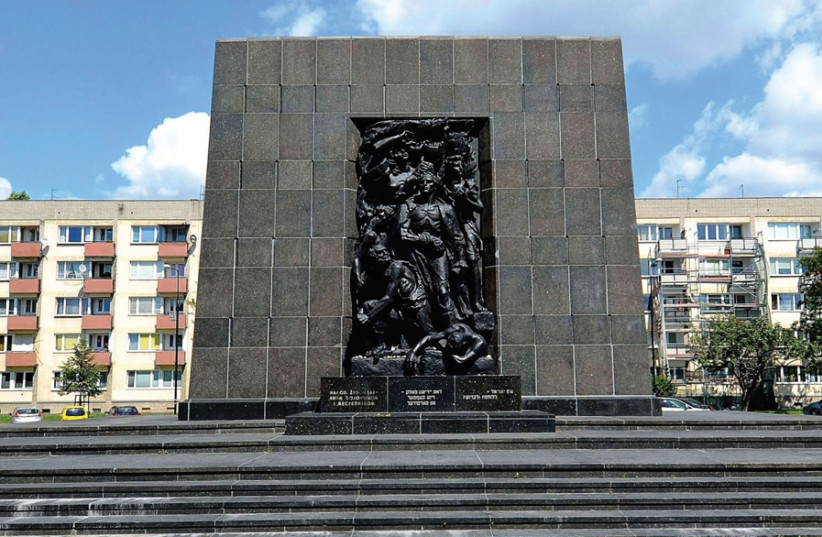On May 16, 1943, the SS’s Brig.-Gen. Jurgen Stroop stood in front of the last untouched structure in the Warsaw Ghetto: the Great Synagogue of Warsaw on Tlomackie Street.
As Stroop recalled: “What a marvelous sight it was. A fantastic piece of theater. My staff and I stood at a distance. I held the electrical device that would detonate all the charges simultaneously. [Chief of Staff Max] Jesuiter called for silence. I glanced over at my brave officers and men, tired and dirty, silhouetted against the glow of burning buildings.
“After prolonging the suspense for a moment I shouted, ‘Heil Hitler’ and pressed the button. With a thunderous, deafening bang a rainbow burst of colors, the fiery explosion soared toward the clouds, an unforgettable tribute to our triumph over the Jews. The Warsaw Ghetto was no more. The will of Adolf Hitler and Heinrich Himmler had been done.”
“What a marvelous sight it was. A fantastic piece of theater. My staff and I stood at a distance."
SS’s Brig.-Gen. Jurgen Stroop
Stroop’s personal demolition of the Great Synagogue of Warsaw was not simply his crowning destruction of the rebelling Jews of the Warsaw Ghetto, but his assault on Jewish civilization, Jewish culture and Jewish history.
The construction of Warsaw’s Great Synagogue, one of the grandest synagogues constructed in the 19th century, was completed in September 1878, just in time for Rosh Hashanah. It was the largest Jewish house of worship in existence at the time. Although not Reform, the synagogue retained some modern practices including a sermon in Polish, not in Yiddish; an all-male choir accompanying services; and an organ that played only at weddings. The services and liturgy were traditional.

Although the Germans continued to be challenged by the ghetto fighters months after the grand synagogue’s destruction, Stroop’s demolition of the Tlomackie street synagogue signaled an end to the dogged resistance of the underground and the struggle to escape by those who had been surviving in the ghetto.
Representation of the synagogue’s destruction
FOR STROOP, the synagogue’s destruction was not simply the demolition of a place of worship. It represented to the brigadier-general an ultimate triumph over the Jewish people, the demolition of their source of life. It was meant to be symbolic. And what it represented was a triumph over Judaism, as well as a triumph over Jews.
Think of all the Torahs and Jewish books burned on November 9-10, 1938 during Kristallnacht. Think of the synagogues burned during the war by the Germans and their collaborators throughout Europe. Think of Prague. The Holocaust Encyclopedia (2001) writes, “Thousands of religious artifacts and prayer books from throughout the German-occupied territories were sent to Prague in an effort to collect and save them; the Nazis meant to use the collection as a mocking display of the extinguished race after the war.”
It was not only a matter of genocide of Jews. The Jewish people were to be relegated to a museum, not simply as a relic. Not only would we be on par with the ancient Babylonians and Assyrians. We would be worse: a sub-human race only remembered by the world only for its evil.
Stroop’s project was to destroy Jews and erase the memory of the Jews of Warsaw. What better way to do the latter than destroy the home of the Jewish spirit and Jewish vitality?
We are a living people today because we survived, because we fought, and because we were liberated. For some, it was a matter of trust in God. We have escaped the museums and we will continue to escape the museums as long as our will to live as Jews remains within us.
In her 1975 history of the Holocaust, historian Lucy S. Dawidowicz describes the war against the Jews: 1933-1945. While I agree with the historian, I would add that the target was more than just Jews – it was Jewish civilization. Those were the embers of Jewish civilization that Brig.-Gen. Jurgen Stroop thought he saw rising from the synagogue to the sky on Tlomackie Street in Warsaw on May 16, 1943.
Yes, the Third Reich succeeded in destroying most of European Jewry. But Jewish life is thriving throughout the world only 80 years after the disaster of physical genocide and cultural annihilation. Stroop’s detonation of the Warsaw Ghetto’s last synagogue would not be the final chapter in the story of the Jewish people.
The writer is the rabbi of Congregation Anshei Sholom in West Palm Beach, Florida.
